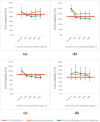Mesalazine and Lactoferrin as Potential Adjuvant Therapy in Colorectal Cancer: Effects on Cell Viability and Wnt/β-Catenin Pathway
- PMID: 40699726
- PMCID: PMC12109867
- DOI: 10.3390/cimb47050327
Mesalazine and Lactoferrin as Potential Adjuvant Therapy in Colorectal Cancer: Effects on Cell Viability and Wnt/β-Catenin Pathway
Abstract
Colorectal cancer (CRC) remains one of the leading causes of cancer-related deaths, meaning it is essential to explore all possible strategies for its prevention and treatment. Unfortunately, risk factors such as an unhealthy lifestyle, lack of exercise, and obesity-which are increasingly prevalent in developed countries-contribute to CRC development. The aim of this study was to evaluate the effect of a mesalazine (MES) and lactoferrin (LACT) combination on the viability of CRC cells and healthy intestinal epithelial cells, as well as to assess the expression profile of target genes within the Wnt/β-catenin pathway. Additionally, this study aimed to preliminarily analyze the mechanism of action underlying the combined effects of these compounds. In this study, we used three CRC cell lines (HCT-116, DLD-1, and HT-29) along with the healthy intestinal epithelial cell line CCD 841 CoN. These cells were treated with MES and LACT separately, as well as in combination. We demonstrated that the combination of MES and LACT reduced the viability of CRC cells more effectively than either compound alone, while slightly increasing the viability of normal intestinal epithelial cells. The synergistic effect of MES and LACT may serve as a foundation for developing new treatment strategies for CRC, utilizing compounds with a high safety profile.
Keywords: colorectal cancer; iron metabolism; lactoferrin; mesalazine.
Conflict of interest statement
The authors declare no conflicts of interest.
Figures





Similar articles
-
Signs and symptoms to determine if a patient presenting in primary care or hospital outpatient settings has COVID-19.Cochrane Database Syst Rev. 2022 May 20;5(5):CD013665. doi: 10.1002/14651858.CD013665.pub3. Cochrane Database Syst Rev. 2022. PMID: 35593186 Free PMC article.
-
Cost-effectiveness of using prognostic information to select women with breast cancer for adjuvant systemic therapy.Health Technol Assess. 2006 Sep;10(34):iii-iv, ix-xi, 1-204. doi: 10.3310/hta10340. Health Technol Assess. 2006. PMID: 16959170
-
Impact of residual disease as a prognostic factor for survival in women with advanced epithelial ovarian cancer after primary surgery.Cochrane Database Syst Rev. 2022 Sep 26;9(9):CD015048. doi: 10.1002/14651858.CD015048.pub2. Cochrane Database Syst Rev. 2022. PMID: 36161421 Free PMC article.
-
The Black Book of Psychotropic Dosing and Monitoring.Psychopharmacol Bull. 2024 Jul 8;54(3):8-59. Psychopharmacol Bull. 2024. PMID: 38993656 Free PMC article. Review.
-
Drugs for preventing postoperative nausea and vomiting in adults after general anaesthesia: a network meta-analysis.Cochrane Database Syst Rev. 2020 Oct 19;10(10):CD012859. doi: 10.1002/14651858.CD012859.pub2. Cochrane Database Syst Rev. 2020. PMID: 33075160 Free PMC article.
References
Grants and funding
LinkOut - more resources
Full Text Sources
Miscellaneous

